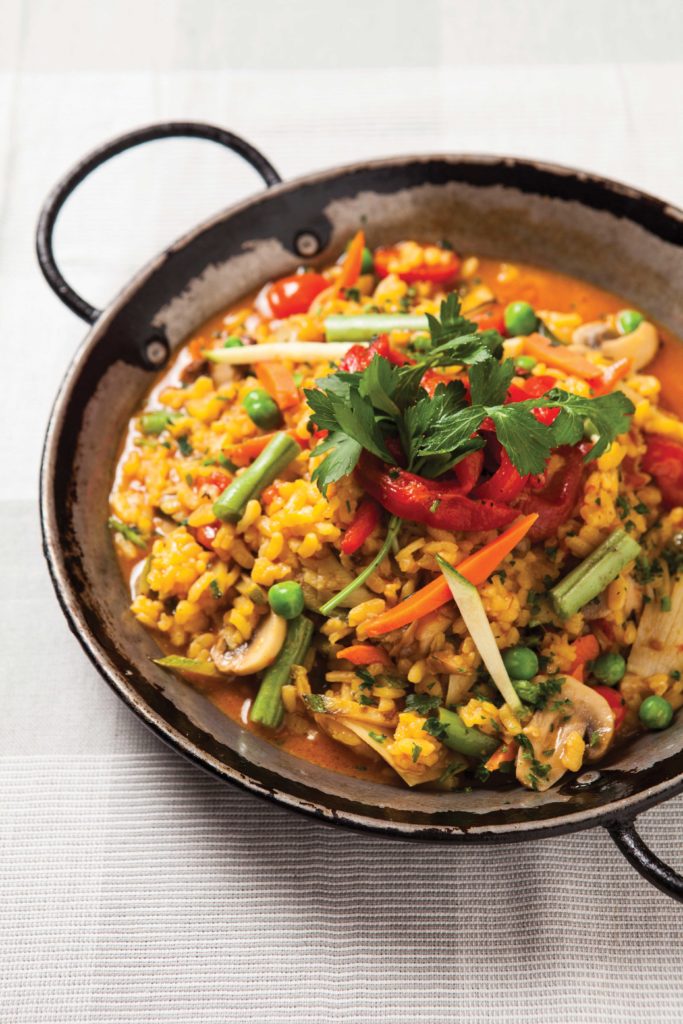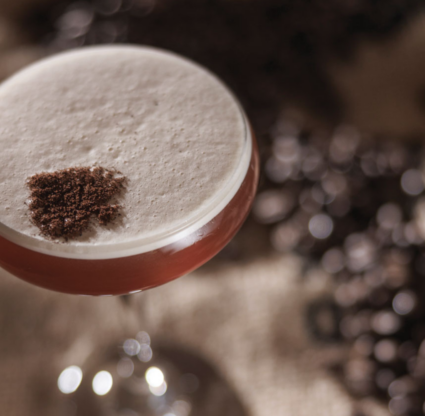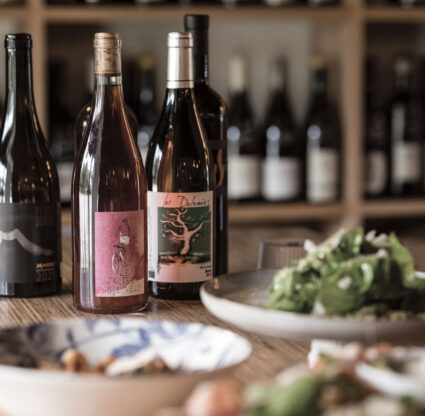With the buzzword “clean” becoming synonymous with eating at every level of the food chain, never before have chefs tried as hard to make sure good-for-you and good-tasting align. Here, we’ve asked five of the Gulfshore’s best chefs to share a favorite healthy recipe from his or her restaurant, along with what each of them has learned along the way in a quest to eat and cook better.
Bryan Sutton
Executive Chef, Veranda E
 If you’ve ventured into the courtyard oasis of the Hotel Escalante on the corner of Fifth and Third in Naples, a quick survey of the verdant potted herbs flanking the restaurant signals why its tables are more populated with locals than visitors. Aside from plucking greens and flowers for his fusion dishes that employ classic French technique, Sutton was one of the first chefs in town to put a premium on Paleo and Whole30 concepts in fine dining. “I have incorporated both of those into our menu, and the majority of it is gluten-free. I eat mostly vegetables and protein—I try to stay away from a lot of heavy, starchy things, even though there’s time for them. Yes, I like my cheesecakes and desserts, but I do cashew cheesecakes and cashew cream for fruit,” Sutton says. “I think if we just pay more attention to how our food is produced, that is the key. My primary meat farmer is local, organic and grass-fed. Yes, some of the cuts may have more fat or look a little funny, but the flavor is so much more—if you start with something that amazing, you don't have to do a lot to it.”
If you’ve ventured into the courtyard oasis of the Hotel Escalante on the corner of Fifth and Third in Naples, a quick survey of the verdant potted herbs flanking the restaurant signals why its tables are more populated with locals than visitors. Aside from plucking greens and flowers for his fusion dishes that employ classic French technique, Sutton was one of the first chefs in town to put a premium on Paleo and Whole30 concepts in fine dining. “I have incorporated both of those into our menu, and the majority of it is gluten-free. I eat mostly vegetables and protein—I try to stay away from a lot of heavy, starchy things, even though there’s time for them. Yes, I like my cheesecakes and desserts, but I do cashew cheesecakes and cashew cream for fruit,” Sutton says. “I think if we just pay more attention to how our food is produced, that is the key. My primary meat farmer is local, organic and grass-fed. Yes, some of the cuts may have more fat or look a little funny, but the flavor is so much more—if you start with something that amazing, you don't have to do a lot to it.”
Grilled Salmon with Charmoula, Butternut Squash and Sautéed Greens
When it comes to fish, my first choice used to be wild-caught, but I think we are starting to overfish some species, so I have been taking another look at farm-raised fish. The Ora King salmon from New Zealand is one that I really like. It crisps nicely and is so sweet and juicy. All of its feed is GMO-free, and the fish are tagged and numbered so you can see how and when they were raised. Charmoula, a Moroccan pesto, if you will, is a great all-around sauce or marinade. It goes with anything—grilled vegetables, meat or fish. It’s light and healthy, and you can make it spicy or not.
Serves 6
Charmoula:
3/4 cup extra-virgin olive oil
2 Tbsp. lemon juice
1 tsp. ground coriander
1 tsp. ground cumin
1 Tbsp. smoked paprika
1/2 tsp. ground cayenne pepper (optional)
1/4 tsp. saffron
4 cloves garlic, minced
1/2 bunch cilantro, chopped
Himalayan salt, to taste
Squash:
1 large butternut squash
2 Tbsp. coconut oil
3 Tbsp. Patak’s curry paste (spicy or mild)
Kale:
1 pound lacinato kale
2 Tbsp. extra-virgin olive oil
2 Tbsp. minced fresh ginger
2 Tbsp. minced shallots
4 ounces chicken stock
Salt and pepper, to taste
Salmon:
1 (36-ounce) Ora King salmon, cut into 6-ounce pieces
1 Tbsp. olive oil
Salt and pepper, to taste
Sunflower sprouts, lemon and edible flowers, for garnish (optional)
1. Prepare charmoula: Mix all ingredients in a bowl. Cover and let sit for 1 hour at room temperature. (Will keep for 1 week refrigerated.)
2. Prepare butternut squash: Preheat oven to 425 degrees. Peel, seed and cut squash into 1-inch dice. Toss with coconut oil (olive oil will also work) and curry paste. Spread squash on baking sheet and bake for 40 minutes or until tender and brown, tossing them halfway through. Transfer to a bowl and reserve.
3. Prepare kale: De-stem, tear and wash kale (or your favorite hardy green). In a hot sauté pan, place oil, ginger and shallots; sauté gently for 1 minute. Add kale, stir and mix for 1 minute, then add stock (water can be substituted). Cook until wilted, and season to taste with salt and pepper. Remove from heat and set aside.
4. Prepare salmon: Preheat grill. Rub salmon with oil and season with salt and pepper. Place on grill and cook pieces 4 minutes on each side for medium-cooked salmon.
5. Serve: Place a spoonful of curried squash in center of a plate; top with a small portion of the sautéed greens. Balance salmon on top. Drizzle charmoula around on the plate. Garnish with sunflower sprouts, a squeeze of lemon and fresh flowers from the garden. Above all, have fun, make a mess and enjoy!
Editor's Note 11/28/2017: Bryan Sutton has since left Veranda E. He is opening a new restaurant in Naples with Lisa Resch of Carolina Catering Company to be called The Rooster Food + Drink. New to the kitchen of Veranda E are Mounir Loqman, formerly of USS Nemo, and Noah Kincaide, who moved to Naples following stints at the prestigious Little Palm Island and The French Laundry.
Jason Goddard
Corporate Chef, Sea Salt Naples, Barbatella and Sea Salt St. Pete
 Long a leader in culinary innovation, the genius behind Sea Salt (and its sister eatery, Barbatella, just steps away on Third Street South) is the collaboration between Goddard, owner Fabrizio Aielli and executive chef Josh Zeman. Together, they rolled out a brand-new lunch menu over the summer with an emphasis on fresh, light, all-in-one nutritious offerings they dubbed “bowls.” The change reflects the broader philosophy the team has, staying on the cutting edge and channeling the zeitgeist. “I think that for so long healthy food has gotten a bad rap. Cooks thought that the same rules didn’t apply because it had to be ‘healthy.’ So the flavors weren’t the same, and people thought it didn’t taste good—which couldn’t be further from the truth,” Goddard says. “What I try to do is make simple, clean food that tastes yummy; it’s good for the mind, body and soul.”
Long a leader in culinary innovation, the genius behind Sea Salt (and its sister eatery, Barbatella, just steps away on Third Street South) is the collaboration between Goddard, owner Fabrizio Aielli and executive chef Josh Zeman. Together, they rolled out a brand-new lunch menu over the summer with an emphasis on fresh, light, all-in-one nutritious offerings they dubbed “bowls.” The change reflects the broader philosophy the team has, staying on the cutting edge and channeling the zeitgeist. “I think that for so long healthy food has gotten a bad rap. Cooks thought that the same rules didn’t apply because it had to be ‘healthy.’ So the flavors weren’t the same, and people thought it didn’t taste good—which couldn’t be further from the truth,” Goddard says. “What I try to do is make simple, clean food that tastes yummy; it’s good for the mind, body and soul.”
Blackened Chicken and Curried Cauliflower Bowl
I love this dish because of the subtle spice from the curried cauliflower, the crunch and tartness of the green apple and the savory note from the chicken. The kefir dressing sets it off. Kefir is a nutritional powerhouse. It is rich in beneficial bacteria that support gut health and is strongly anti-inflammatory. When you get it from the milk of grass-fed cows or goats, you enjoy the additional benefit of healthy fats like conjugated linoleic acid and omega-3 fatty acids.
Serves 4 to 6
Blackened chicken breast:
4 (7-ounce) boneless skinless chicken breasts
1 tsp. extra-virgin olive oil
Blackened seasoning, such as Zatarian’s or a homemade blend
Curried cauliflower:
1 medium head cauliflower, chopped into 2-inch pieces (about 6 cups)
1 Tbsp. extra-virgin olive oil
1 tsp. yellow curry powder
1/4 tsp. crushed sea salt
Freshly ground black pepper, to taste
Kefir dressing:
1/2 cup kefir
3 Tbsp. red wine vinegar
2 Tbsp. chopped dill
1/4 cup extra-virgin olive oil
Salt and pepper, to taste
For the salad:
2 medium romaine hearts, cleaned and cut into 2-inch pieces
2 green apples, cored and diced
1/4 cup dried currants
1/4 cup hazelnuts, toasted and crushed
6 ounces kefir dressing
Extra-virgin olive oil, salt and pepper, to taste (optional)
1. Prepare chicken and cauliflower: Arrange 2 racks in the oven and preheat to 400 degrees. Put chicken breasts in a roasting pan or on a rimmed baking sheet; brush with olive oil and dust with blackened seasoning. Toss cauliflower with oil, curry powder, salt and pepper in a bowl; arrange in a single layer on a rimmed baking sheet or glass baking dish. Transfer both to oven. Roast for 20 minutes. Remove cauliflower from oven and let cool. Continue roasting chicken for an additional 10 to 15 minutes until a meat thermometer registers 160 degrees. Remove from the oven and cool.
2. Prepare kefir dressing: Combine kefir, vinegar, chopped dill and olive oil in a bowl. Add salt and pepper; adjust seasoning as necessary.
3. To serve: In a large mixing bowl, combine curried cauliflower with romaine, apples, currants, hazelnuts and kefir dressing. Taste and add olive oil, salt or pepper, if desired. Top with sliced blacken chicken and serve right away.
Gloria Jordan d’Cabral
Chef-Owner, La Trattoria Café Napoli and Mermaid Garden Café
 The queen bee of the Fort Myers farm-to-table scene is a vibrant Cubana with a European pedigree and training—and it shows through at her La Trattoria Café Napoli (what most regulars affectionately call “Gloria’s”) and her casual brunch spot Mermaid Garden Café. At La Trattoria, she effortlessly mixes tapas from her home country with those of her ancestral land, plus dishes from around the Mediterranean to boot. For both endeavors, she favors recipes that showcase a rainbow of vegetables. “I adore paella for many reasons—it is easy, quick, healthy and you can modify it very simply. It is comfort food, and it’s so hard to put the fork down when done,” Jordan d’Cabral says. “I have tried it with many kinds of whole grains, and every one is a different experience for texture, but the flavor is there. I serve it at the restaurant as traditional as possible, with Valencia rice, but you can also make it with any kind of brown rice—I prefer jasmine brown because it’s extra aromatic—or farro or red or black quinoa.”
The queen bee of the Fort Myers farm-to-table scene is a vibrant Cubana with a European pedigree and training—and it shows through at her La Trattoria Café Napoli (what most regulars affectionately call “Gloria’s”) and her casual brunch spot Mermaid Garden Café. At La Trattoria, she effortlessly mixes tapas from her home country with those of her ancestral land, plus dishes from around the Mediterranean to boot. For both endeavors, she favors recipes that showcase a rainbow of vegetables. “I adore paella for many reasons—it is easy, quick, healthy and you can modify it very simply. It is comfort food, and it’s so hard to put the fork down when done,” Jordan d’Cabral says. “I have tried it with many kinds of whole grains, and every one is a different experience for texture, but the flavor is there. I serve it at the restaurant as traditional as possible, with Valencia rice, but you can also make it with any kind of brown rice—I prefer jasmine brown because it’s extra aromatic—or farro or red or black quinoa.”
Vegetarian Paella
This recipe is vegan, but you can add seafood or meat or even a mix. It is perfect to serve for friends or family on any night of the week or for any kind of gathering. I love to see the beautiful shallow paella pan full of color; it’s very aromatic. A good tip: You can substitute any of the vegetables for whatever you like best.
Serves 4
3 Tbsp. extra-virgin olive oil
3 garlic cloves, finely chopped
1 medium Spanish onion, chopped
1 medium red bell pepper, chopped
1/4 cup diced carrots
1/4 cup diced zucchini
1/4 cup green peas
10 medium green olives
1 whole plum tomato, chopped
1 pinch of saffron
1 cup short grain rice, preferably Valencia (also called “bomba”)
1 tsp. smoked paprika
1 tsp. fresh or dried oregano
1 tsp. salt
1/2 tsp. white pepper
3 cups vegetable broth, preferably freshly made
Fresh chopped parsley, for garnish
Lemon rounds or wedges, for garnish
1. Add olive oil to a large pan and place over medium-high heat. Add garlic, onion and all vegetables that need a longer time to cook. Keep stirring to prevent the mixture from burning.
2. Add the saffron and rice and all the rest of the ingredients except for the broth and garnishes. Continue stirring until everything has an even gold color.
3. Add broth; let it simmer for a few minutes, stirring and bringing the heat to low. Cover pan with a piece of foil and finish cooking in the oven at 350 degrees (or keep it covered on top of the stove) until the broth has almost disappeared. Remove from heat.
4. Divide among bowls or plates, and garnish with chopped fresh parsley and lemon slices. For an extra touch, drizzle some olive oil. Olé!
James Waller
Chef-Owner, Côte D’Azur
 From the charmingly mismatched porcelain plates to the sunny awnings above the tables, this ode to the south of France is the gold standard for relaxed fine dining in North Naples. Waller and his wife, Darlene, as its new owners, and the Northern California transplants are intent on preserving the classic Mediterranean recipes and weaving in some of James’s own, like this one here. He has also been rethinking his supply chain in anticipation of season. “People want to know where their food is coming from. I feel strongly about this. The olive oil we’ve been using is wonderful, and it’s from France—I’m not going to start buying California olive oil—but I want the waiters to be able to say the tomatoes came from such and such farm and know the heritage of the proteins,” Waller says. “That is going to take time for research, education and networking with vendors, but that’s where I ultimately want to take this restaurant.”
From the charmingly mismatched porcelain plates to the sunny awnings above the tables, this ode to the south of France is the gold standard for relaxed fine dining in North Naples. Waller and his wife, Darlene, as its new owners, and the Northern California transplants are intent on preserving the classic Mediterranean recipes and weaving in some of James’s own, like this one here. He has also been rethinking his supply chain in anticipation of season. “People want to know where their food is coming from. I feel strongly about this. The olive oil we’ve been using is wonderful, and it’s from France—I’m not going to start buying California olive oil—but I want the waiters to be able to say the tomatoes came from such and such farm and know the heritage of the proteins,” Waller says. “That is going to take time for research, education and networking with vendors, but that’s where I ultimately want to take this restaurant.”
Crevettes en Colère avec Espelette
The cuisine from Provence has so much of what I love to work with. There is something very important about eating well with amazing flavors that are both bold and balanced, as is the case in these “angry” shrimp. I have spent many years being around very good cooks, tasting and trying different styles and cuisines, but what I have found is that the Mediterranean ingredients and cooking techniques are what I enjoy the most, and they happen to be the healthiest.
Serves 2
8 (U-12) shrimp, wild-caught from the Gulf of Mexico
1 tsp. ground espelette, a chili powder from France
1 tsp. acuka, a piquant Turkish paste
1 1/2 Tbsp. chopped flat-leaf parsley
1 tsp. chopped thyme
1 tsp. kosher salt
2 Tbsp. olive oil
1 Tbsp. sliced garlic
1 tsp. chopped shallots
Juice of 1/2 lemon
3 Tbsp. Chardonnay or Sauvignon Blanc
1 tsp. capers
8 to 10 cherry tomatoes, cut in half
1/4 cup unsalted butter, cubed
1/4 cup sliced baby artichokes (steamed and cleaned in advance)
1. Clean shrimp: Butterfly and loosen shells but do not remove.
2. Prepare a rub with half the espelette and acuka and half the herbs and salt.
3. Place 1 Tbsp. of the olive oil on shrimp and coat with the rub.
4. Heat grill or griddle on medium-high and place shrimp meat side-down and cook for 3 minutes, then flip to shell side and finish cooking 2 to 3 more minutes. The shrimp meat should easily be removed when eating if cooked through properly. Set aside and keep warm.
5. In a sauté pan over medium-high heat, sauté garlic slices and shallots in the remaining olive oil.
6. Once garlic starts to be clear, add lemon juice, remaining espelette and acuka and cook for 2 minutes.
7. Add Chardonnay, capers and cherry tomatoes and reduce au sec (until almost dry).
8. Slowly add pieces of butter and remaining herbs.
9. Taste sauce and adjust seasoning. If you prefer it spicier, add more espelette.
10. Place sauce in bowl or on a plate and arrange the grilled shrimp and artichokes around it.
Harold Balink
Chef-Owner, Harold’s
 He’s a certified sommelier and has cooked at the James Beard House in New York, but the reason people return time and again to his coziest of cozy bistros in Fort Myers is his reliance on what’s local and in season—not to mention, his zeal for thinking on his feet, as the menu changes weekly (“Expecting the unexpected” could be his restaurant’s tagline). “Farm to table started as a fad, but as people realize how much better and less expensive it can be, it’s snowballing,” Balink says. “This is the way everyone used to eat. Gardens are popping up everywhere. So are farmers markets, chef’s cooking classes—all things that will help people eat healthier and spend their money locally. If the farmer does it right, his product helps foster a healthier lifestyle. Cooking shows are another huge help, as people are excited again to be in the kitchen, and it has returned to being the main room in the house. All of this is gravy to chefs, as conversations are more intellectual about food, and we have to push ourselves to be more creative and serve better food.”
He’s a certified sommelier and has cooked at the James Beard House in New York, but the reason people return time and again to his coziest of cozy bistros in Fort Myers is his reliance on what’s local and in season—not to mention, his zeal for thinking on his feet, as the menu changes weekly (“Expecting the unexpected” could be his restaurant’s tagline). “Farm to table started as a fad, but as people realize how much better and less expensive it can be, it’s snowballing,” Balink says. “This is the way everyone used to eat. Gardens are popping up everywhere. So are farmers markets, chef’s cooking classes—all things that will help people eat healthier and spend their money locally. If the farmer does it right, his product helps foster a healthier lifestyle. Cooking shows are another huge help, as people are excited again to be in the kitchen, and it has returned to being the main room in the house. All of this is gravy to chefs, as conversations are more intellectual about food, and we have to push ourselves to be more creative and serve better food.”
Harold’s Chicken Tikka Masala
My favorite healthful entrée is this twist on a classic Indian dish. It’s made with spiced nonfat Greek yogurt and served with sweet potato mash and garlicky kale in place of rice or naan.
Serves 4 to 6
Chicken:
2 whole chickens, preferably from Circle C Farm
1 chicken bouillon
2 cups nonfat Greek yogurt
2 Tbsp. garam masala
2 Tbsp. coriander
2 Tbsp. cumin
2 Tbsp. turmeric
1 Tbsp. minced ginger
1 Tbsp. sea salt
1 Tbsp. black pepper
Olive oil
Sweet potato:
2 sweet potatoes, peeled
2 Tbsp. coconut butter
Pinches of salt, pepper and cinnamon
Kale:
1 Tbsp. grapeseed oil
1 Tbsp. minced garlic
1 head kale, de-stemmed and chopped
Salt and pepper, to taste
1/2 cup white wine
1. Prepare chicken: Poach chickens in chicken bouillon at 165 degrees for 2 hours. Cool, then cut chickens in half and debone except for thigh bones. Combine all other ingredients and coat chicken generously. Chill overnight.
2. Preheat oven to 450 degrees and in a large nonstick skillet over medium-high heat add olive oil and sear all sides of the chicken to light red. Place on a nonstick sheet pan and finish in oven until warm in center (about 10 minutes).
3. Prepare sweet potato: Poach sweet potato until tender. Mash in bowl and combine all ingredients. Keep warm.
4. Prepare kale: In a pan over high heat, add oil, garlic and kale. Sauté vigorously. Season with salt and pepper; add wine. Cook for 2 minutes, then serve immediately.
5. To serve: Divide chicken, sweet potato mash and kale onto plates.





